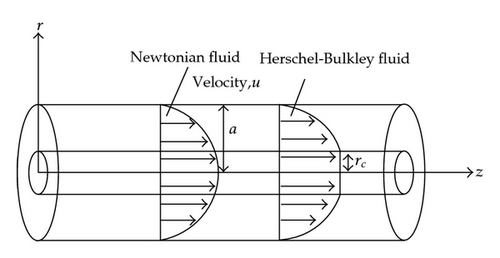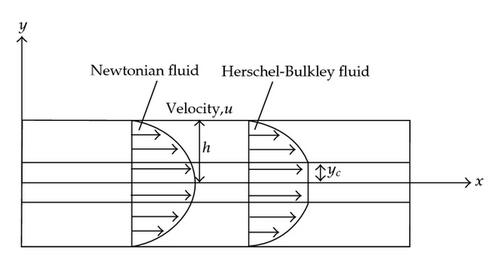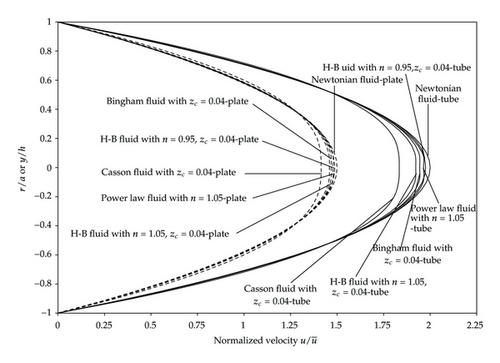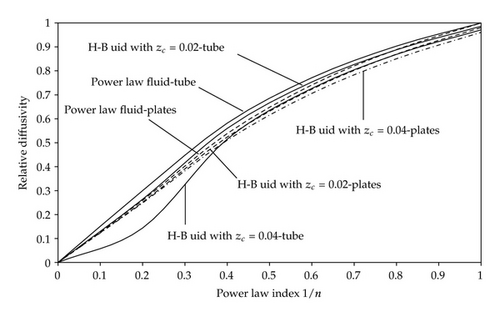Nonlinear Analysis for Shear Augmented Dispersion of Solutes in Blood Flow through Narrow Arteries
Abstract
The shear augmented dispersion of solutes in blood flow (i) through circular tube and (ii) between parallel flat plates is analyzed mathematically, treating blood as Herschel-Bulkley fluid model. The resulting system of nonlinear differential equations are solved with the appropriate boundary conditions, and the expressions for normalized velocity, concentration of the fluid in the core region and outer region, flow rate, and effective axial diffusivity are obtained. It is found that the normalized velocity of blood, relative diffusivity, and axial diffusivity of solutes are higher when blood is modeled by Herschel-Bulkley fluid rather than by Casson fluid model. It is also noted that the normalized velocity, relative diffusivity, and axial diffusivity of solutes are higher when blood flows through circular tube than when it flows between parallel flat plates.
1. Introduction
The dispersion of a solute in a solvent flowing in a pipe/channel is an important physical phenomenon, which has wide applications in many fields of science and engineering and some potential application fields are chemical engineering, biomedical engineering, physiological fluid dynamics, and environmental sciences [1]. The physics involved in the dispersion theory is the spreading of a passive species (solute) in a flowing fluid (solvent) due to the combined action of molecular diffusion and nonuniform velocity distribution [2]. For better understanding of the concept of shear-augmented dispersion, let us consider a bolus of a solute in the fully developed laminar flow of an incompressible fluid in a conduit. The bolus is carried downstream by the Poiseuille flow and is subjected to the resulting transverse concentration gradient. At the leading edge of the bolus, the bolus diffuses from the high concentration region near the centre of the tube towards the low concentration region at the wall [3].
Taylor [4] initiated the study on the dispersion of solutes in fluid flow and reported that if a solute is injected into a solvent flowing steadily in a straight tube, the combined action of the lateral molecular diffusion and the variation of velocity over the cross-section would cause the solute ultimately to spread diffusively with the effective molecular diffusivity Deff given by , where Dm is the molecular diffusivity, wm is the normalized axial velocity, and a is the radius of the tube. He also pointed out that the spreading of the solute is symmetrical about a point moving with the average velocity wm of the fluid. Since many intravenous medications are therapeutic at low concentration, but toxic at high concentration, it is important to know the rate of dispersion of the material in the circulatory system [5]. The main objective of this study is to analyze the dispersion of solutes in blood flow. Sankarasubramanian and Gill [6] discussed the dispersion of solute undergoing first-order wall retention in Poiseuille flow through circular tube. Their generalized dispersion model gives rise to three effective transport coefficients, namely, the convection, the diffusion, and the exchange coefficients. Lungu and Moffatt [7] analyzed the effect of wall conductance on heat diffusion using Fourier transform with average function to obtain a series solution. Tsangaris and Athanassiadis [8] investigated the diffusion of solutes in an oscillatory flow in an annular pipe.
When blood flows through arteries and veins, it shows many fluid dynamic complexities such as pulsatility, curvature, branching and elasticity of walls, and thus, the dispersion of solutes in blood flow is affected by these factors as well as reactions and the multiphase character of fluid [9]. Hence, it is important to understand the modifications caused by non-Newtonian rheology to the dispersion of passive species. This analysis can also be applied to blood handling devises too. Rao and Deshikachar [10] studied the dispersion of solute in a steady flow of incompressible fluid in an annular pipe and showed that the axial dispersion of the normalized concentration decreases with the increase of the inner radius of the cylinder. They reported that the asymptotic solution, for large time, of effective diffusivity in the flow directions is a decreasing function of the wall conductance. Mazumdar and Das [11] investigated the effect of wall conductance on the axial dispersion in the pulsatile tube flow.
Sharp [12] investigated the shear-augmented dispersion of solutes in the steady flow of Casson fluid through a circular pipe and also flow between parallel plates using Taylor model [4]. Jiang and Grotberg [13] studied the dispersion of a bolus contaminant in a straight tube with oscillatory flow field and weak conductive walls and reported that the axial dispersion diminished by the wall conductance when the frequency parameter exceeds the critical value. Smith and Walton [14] discussed the dispersion of solutes in the fluid flow through inclined tube with an annulus. The dispersion of solutes in the flow of power law fluids was analyzed by Agarwal and Jayaraman [1]. They showed that the effective molecular diffusivity varies with yield stress for Casson and Bingham fluids and power law index in the case of power-law fluids. Dash et al. [15] studied the shear augmented dispersion of a solute in the Casson fluid flow in a conduit using the generalized dispersion model of Gill and Sankarasubramanian [16].
Herschel-Bulkley (H-B) fluid model and Casson fluid model are the non-Newtonian fluid models that are generally used in the studies of blood flow through narrow arteries [17, 18]. Tu and Deville [19] and Sankar et al. [20] mentioned that blood obeys Casson’s equation only for moderate shear rate, whereas the H-B equation can still be used at low shear rates and represent fairly closely what is occurring in blood. Several researchers proved that for tube diameter 0.095 mm blood behaves like H-B fluid rather than power law and Bingham fluids [21, 22]. Iida [23] reports “The velocity profile in the arterioles having diameter less than 0.1 mm are generally explained fairly by Casson and H-B fluid models. However, the velocity profiles in the arterioles whose diameters are less than 0.065 mm do not conform to the Casson model, but, can still be explained by H-B model.” Hence, it is appropriate to model blood as H-B fluid model rather than Casson fluid model when it flows through smaller diameter arteries. The theoretical analysis of shear-augmented dispersion in the steady flow of H-B fluid through circular tube has not been studied so far, to the knowledge of the authors. Hence, in this paper, we analyze the shear augmented dispersion of solutes in the steady flow of H-B fluid through a narrow cylindrical tube with possible application to blood flow. Since, some devices involve the flow between parallel flat plates or membranes rather than flow in tubes [12], the study on the dispersion of solutes in fluid flow between parallel flat plates is also important. Thus, it is also aimed to investigate the shear-augmented dispersion of solutes in the incompressible fluid flow between parallel flat plates. The layout of the paper is as follows.
Section 2 formulates the problem mathematically and then solves the resulting system of differential equations to obtain the expression for the flow quantities such as normalized velocity, concentration of the fluid in the core region and outer region, flow rate, and the effective axial diffusivity. The effects of various parameters such as power law index and yield stress on these flow quantities are discussed through appropriate graphs in the numerical simulation of the results and discussion Section 3. Also, some possible physiological application of this study to blood flow is given in Section 3. The main results are summarized in the concluding Section 4.
2. Mathematical Formulation
Consider the dispersion of a solute in the axi-symmetric, steady, laminar, and fully developed unidirectional flow (in the axialdirection) of Herschel-Bulkley (H-B) fluid (viscous incompressiblenon-Newtonian fluid) through (i) circular tube and (ii) between parallel flat plates. The geometry of the flow fields in circular tube and between parallel flat plates are shown in Figures 1(a) and 1(b), respectively.


2.1. Flow in Circular Tube
2.1.1. Governing Equations
2.1.2. Solution Method
2.2. Flow between Parallel Flat Plates
2.2.1. Governing Equations
2.2.2. Solution Method
3. Results and Discussion
The objective of this study is to analyze the blood flow characteristics due to the shear augmented dispersion of solutes when blood flows (i) through circular tubes and (ii) between parallel flat plates, modeling blood as H-B fluid. It is also aimed to discuss the effects of various physical parameters on the velocity distribution of blood, relative diffusivity, and effective axial diffusivity of the solute [19].
3.1. Normalized Velocity Distribution
The normalized velocity profiles of H-B and Casson fluids (for different values of the power law index zc and yield stress n) flow (i) through circular tube and (ii) between parallel flat plates are sketched in Figure 2. It is observed that the normalized velocity decreases marginally with the increase of power law index and yield stress. It is also seen that the normalized velocity of Newtonian fluid model is marginally higher than those of the H-B and Casson fluid models, and it is slightly higher than that of Power law fluid model. It is clear that the normalized velocity of H-B fluid model is considerably higher than that of the Casson fluid model. One can notice that the normalized velocity of any fluid model when it flows between parallel flat plates is very similar to its normalized velocity when it flows through a circular tube. It is of interest to note that the normalized velocity profile of the Newtonian fluid model is in good agreement with the corresponding normalized velocity profile in Figure 3 of Sharp [12].


3.2. Relative Diffusivity
The variation of relative diffusivity with yield stress of H-B and Casson fluids when flowing (i) through circular tube and (ii) between parallel flat plates is shown in Figure 3. It is observed that the relative diffusivity decreases slowly with the increase of the yield stress of H-B and Bingham fluid models, but it decreases rapidly (nonlinearly) with the increase of the yield stress for Casson fluid model. It is also noted that the relative diffusivity decreases considerably with the increase of the power law index of the H-B fluid model. It is also found that the relative diffusivity is significantly higher for H-B fluid model than that of the Casson fluid model. It is seen that for any fluid model, the relative diffusivity is higher when it flows through circular pipe than when it flows between parallel flat plates.
Figure 4 sketches the variation of relative diffusivity with the reciprocal of the power law index for H-B and power law fluids when they flow (i) through a circular tube and (ii) between flat plates. It is clear that for power law fluid, the relative diffusivity increases rapidly with the increase of the reciprocal of the power law index from 0 to 0.5, and then it increases slowly with the increase of the reciprocal of the power law index from 0.5 to 1. The same behavior is also noticed for H-B fluid, but some nonlinearity is found at lower values of the reciprocal of the power law index. It is noted that for both H-B and power law fluid models, the relative diffusivity increases almost linearly with the increase of the reciprocal of the power law index. It is found that the relative diffusivity is marginally higher for power law fluid model than that of the H-B fluid model.

3.3. Some Physiological Applications
The estimates of yield stress zc and relative diffusivity in the canine vascular system are useful to understand the dispersion of solutes in blood flow through arterioles, venules, inferior vena cava, and ascending aorta. Using the expressions obtained for flow in tubes, the estimates of yield stress zc and relative diffusivity in the canine vascular system [12, 24] (in arteries of different diameters) are computed in Table 1. It is observed that the estimates of the relative diffusivity decreases slowly with the increase of the yield stress. It is also noted that the relative diffusivity decreases gradually with the increase of the power law index. It is found that the solute disperses rapidly in arterioles than in ascending aorta. It is also noticed that the solute dispersion is faster when blood is modeled by H-B fluid or Bingham fluid than when it is modeled by Casson fluid.
| E/A2 | |||||||
|---|---|---|---|---|---|---|---|
| Velocity (cm/s) | Diameter (cm) | zc | H-B fluid | Bingham fluid | Casson fluid | ||
| n = 0.95 | n = 1.05 | ||||||
| Arterioles | 0.75 | 0.005 | 0.00654 | 1.0186 | 0.9749 | 0.9955 | 0.9544 |
| Venules | 0.35 | 0.004 | 0.01120 | 1.0141 | 0.9716 | 0.9922 | 0.9391 |
| Inferior vena cava | 25.00 | 1.000 | 0.03920 | 0.9863 | 0.9503 | 0.9719 | 0.8761 |
| Ascending aorta | 20.00 | 1.500 | 0.07370 | 0.9495 | 0.9207 | 0.9450 | 0.8179 |
From the expressions obtained for flow between parallel flat plates, the estimates of yield stress zc and relative diffusivity in the same canine vascular system are computed in Table 2. It is noted that the variation in the relative diffusivity with the yield stress/diameter of the canine artery is the similar to the one that was observed in the case of flow in tube flow in Table 1. From Tables 1 and 2, it is observed that for any fluid model, the relative diffusivity of the solute is slightly higher when it disperses in circular tube than when it disperses between parallel flat plates.
| N/F2 | |||||||
|---|---|---|---|---|---|---|---|
| Velocity (cm/s) | Diameter (cm) | zc | H-B fluid | Bingham fluid | Casson fluid | ||
| n = 0.95 | n = 1.05 | ||||||
| Arterioles | 0.75 | 0.005 | 0.00654 | 1.0167 | 0.9700 | 0.9938 | 0.9434 |
| Venules | 0.35 | 0.004 | 0.01120 | 1.0136 | 0.9655 | 0.9894 | 0.9245 |
| Inferior vena cava | 25.00 | 1.000 | 0.03920 | 0.9942 | 0.9378 | 0.9616 | 0.8479 |
| Ascending aorta | 20.00 | 1.500 | 0.07370 | 0.9700 | 0.9018 | 0.9251 | 0.7787 |
4. Conclusion
- (i)
The normalized velocity of blood flow is considerably higher when it is modeled by H-B fluid rather than Casson fluid model.
- (ii)
The normalized velocity of blood is significantly higher when it flows through circular tube than when it flows between parallel plates.
- (iii)
The relative diffusivity and axial diffusivity of the solute are marginally higher when blood is modeled by H-B fluid rather than by Casson fluid.
- (iv)
The relative diffusivity and axial diffusivity of the solute are slightly higher when blood flows in circular tubes than when it flows between parallel flat plates.
- (v)
The normalized velocity of blood, relative diffusivity, and axial diffusivity of solute decrease with the increase of the yield stress of the blood.
Based on these results, one can note that there is a substantial difference between the flow quantities of H-B fluid model (present results) and Casson fluid model (results of Sharp [12]), and thus, it is expected that the present H-B model may be useful to predict physiologically important flow quantities. Hence, it is concluded that the present study can be treated as an improvement in the mathematical modeling of dispersion of solutes in blood flow through narrow diameter arteries. Since the solutes may disperse unsteadily, the study on the unsteady diffusion of solutes in blood flow with effects on boundary absorption would be more realistic, and this will be done in the near future.
Acknowledgment
The present work is supported by the research university grant of Universiti Sains Malaysia, Malaysia (Grant no.: 1001/PMATHS/811177).




